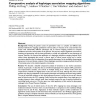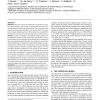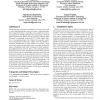7134 search results - page 4 / 1427 » A comparative study of map use |
BMCBI
2006
13 years 7 months ago
2006
Background: Finding the genetic causes of quantitative traits is a complex and difficult task. Classical methods for mapping quantitative trail loci (QTL) in miceuse an F2 cross b...
BIOINFORMATICS
2007
13 years 7 months ago
2007
Motivation: Genome maps are fundamental to the study of an organism and essential in the process of genome sequencing which in turn provides the ultimate map of the genome. The in...
EUROMED
2010
13 years 6 months ago
2010
Abstract. Museums research new ways to offer positive experience to the visitors and encourage them to return, using modern communication and learning tools. To the effect, technol...
ACMACE
2008
ACM
13 years 9 months ago
2008
ACM
Dimensionality reduction is a statistical tool commonly used to map high-dimensional data into lower a dimensionality. The transformed data is typically more suitable for regressi...
CHI
2007
ACM
14 years 8 months ago
2007
ACM
It is well-established finding that people find maps easier to use when they are aligned so that "up" on the map corresponds to the user's forward direction. With m...



